» Home
» About
» Membership
» Journal
» Sparoza Garden
» Branches
» MGS Forum
» Seed Exchange
» Donations
» MGS Excursions
» Information
» Members' Gardens
» Book Reviews
» News & Views
» Contact
» Search
|
11th Annual General Meeting 2005
Carmona, Spain
Friday 21st October - Botanical Garden, Córdoba
The Botanic Garden of Cordoba was founded in 1980 on the basis of an agreement signed between the University of Cordoba and the City Council and was officially opened in May 1987.
One of the main achievements of the Botanic Garden is the Andalusian Plant Germplasm Bank, which aims to conserve Andalusian flora and wild phytogenetic resources, especially endangered species.
The garden covers six hectares of land alongside the Guadalquivir River and is divided into areas dedicated to different collections. Part of the one thousand square metres under glass houses the Canary Island plant collection.
The Agricultural School Garden is devoted to plants that are or have been useful for different peoples around the Mediterranean Basin and is a recreation of a typical vegetable garden in the Mediterranean area, especially those found along riverbanks or around villages. One of the most impressive elements is the use of citrus hedges, typical in Andalusia and especially Cordoba. Low hedges bordering the vegetable plots include aromatic species such as rosemary (Rosmarinus officinalis), bush germander (Teucrium fruticans), lavender cotton (Santolina chamaecyparissus) and myrtle (Myrtus communis 'Microphylla'), but also grow flowering plants such as dwarf pomegranate (Punica granatum 'Nana'), calendula (Calendula officinalis), carnations (Dianthus barbatus) or wallflower (Mathiola incana).
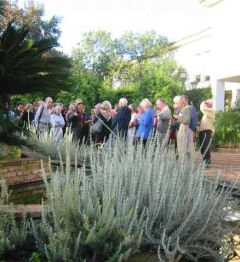
The pretty Rosmarinus tomentosum is an Andalucian endemic
so rare that at the moment the Botanical Garden does not even
have permission to offer it to other botanic institutions. It is
grown here at the entrance to the Garden to demonstrate what
a wonderful garden plant it could be.

A selection of Canary Island plants grown under glass. The Geranium
canariense in the foreground was unhappy in the harsh sunlight of Sparoza.
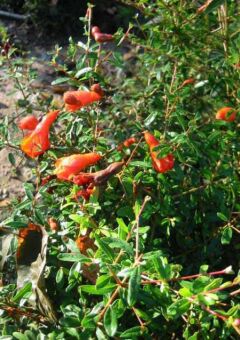
Dwarf pomegranate (Punica granatum 'Nana') as a
colourful hedging plant.
Palacio de Viana, Córdoba
The palace of the Marques de Viana, a residence now owned by the bank Caja Sur, is a wonderful example of patio gardening. This complex of many small buildings contains a total of 12 patios and one formal garden. Also noteworthy are the paving methods, typical of Cordoba. The various patios demonstrate many different styles and seasonal plantings. Even though its peak season is Spring, early Autumn also has a showing of many interesting blooms. Of particular interest are the patios lined with espaliered citrus trees, even including one with the, relatively rare these days, bergamot.
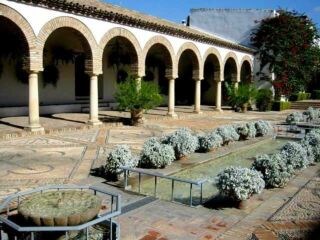
The simplicity of the planting of cinerarias in this patio contrasts with the
complexity of the paving.
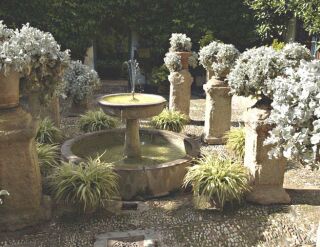
Again simple plants in pots, but the citrus espaliered against the far wall
is the rare bergamot - as known from Earl Grey tea.
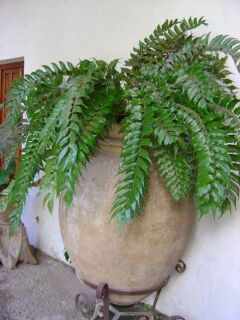
Strong leaf shape defines many of the potted plants.
Here a Holly Fern Cyrtomium falcatum.
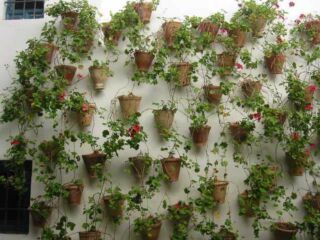
A patio specialty - the wall of flowerpots, usually holding geraniums.
Here a Holly Fern #336600 Cyrtomium falcatum.
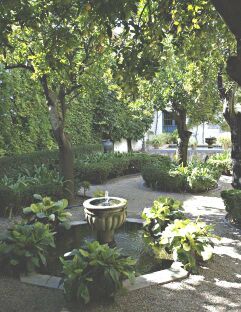
A patio shaded by citrus trees with bergenia in pots
and agapanthus enclosed by myrtle hedges.
Hacienda, Hornachuelos, Provincia de Córdoba
The house with its surroundings, built in the early 1900s, is poised on a hilltop affording unique panoramic views. The owner is in the tradition of many generations of her family, a dedicated and knowledgeable gardener. All sections of the garden - the rose garden, the orange orchard, the paths - are stamped with her personality and sense of the sculptural.
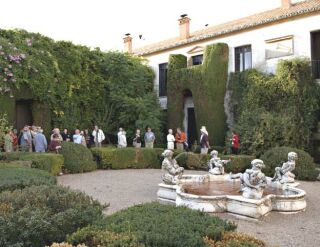
The entrance to the house is framed by a clipped yew. Our hostess pointed
out that one of the cherubs on the fountain was modelled on grandfather.
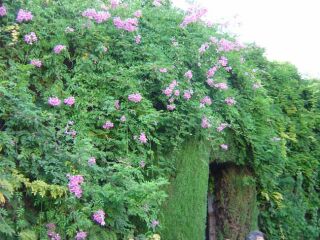
A Podranea scrambling over the yew hedge.
Photgraphs by Davina Michaelides and Alisdair Aird
|


